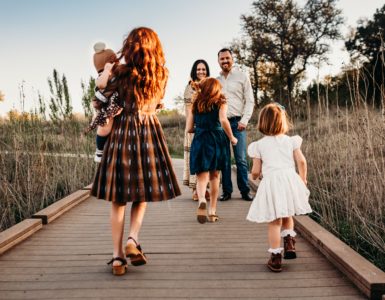The fact of the matter stands that adopting a child in the US may seem overwhelming to both biological parents and prospective adoptive parents. Here are eight considerations from each side to consider when looking at adopting a child in the US.
1. Decide what route to take.
This is a big question, and there is no wrong answer. Prospective parents can choose from several different routes to grow their forever family. Each one is also a different option for the biological family as well. These options include adoption from foster care or domestic adoption. Agencies like the Gladney Center for Adoption can walk both biological and prospective adoptive parents through each process, but here is a quick overview.
Domestic adoption can occur in many ways. The biological parent can seek out prospective adoptive parents on their own, go through the courts to terminate their rights, and place the baby with the adoptive parents in an appointed manner (immediately at birth, after a few days, etc.). The legal proceedings necessary to complete the adoption may vary from state to state, so it can be extremely helpful to connect with experienced legal advocates/counsel in the area. Domestic adoption can also be performed within a family via kinship adoption. Alternatively, it can be completed through an agency where the biological parents are presented with profiles of prospective adoptive parents. This process allows biological parents to have a broader spectrum of vetted families to choose from and gives them an in-depth look at the forever family the child will be placed with.
Adoption from foster care usually occurs when the infant is placed as a ward of the state immediately. Then they are placed with a waiting family chosen by the state. Adoptive families must get a foster care license and are considered foster parents until the adoption is finalized in court. Other options for infant adoption through foster care may include prospective parents connecting with a state’s safe haven program. Through this program, unharmed infants who are left at a safe location (such as a baby box, a fire station, a hospital, etc.) within a certain time frame from birth are considered relinquished to the state. The biological family remains anonymous and the child is placed immediately in a foster home. Usually, they are considered legally adoptable immediately and available for placement. Some states may have a different way of handling the process. Every state has a safe haven regulation. Some allow infants to be relinquished within 30 days, but most are 3-7 days after birth. Usually, these babies are relinquished by a parent in crisis, so there may be an interim period to make sure the biological parent doesn’t change their mind.
2. Connect with people to help you along the way.
Whether you are a biological parent looking to place your child in a loving home, or a prospective adopting parent who is looking to adopt, social workers are an invaluable part of the process. While an agency isn’t necessarily required for adoption, this is a serious legal matter that no one wants to mess up. It requires a lot of support for all parties involved. The task of doing all of the research, the matching, financing, and supporting can be understandably overwhelming. This is where agencies come in. There are many to choose from. Websites like adoption.com can give families a list of agencies to assist along the way. Agencies can assist in background searches of prospective parents and can help coordinate any of the necessary steps for foster care licenses or interstate communications that may be required, depending on the situation.
A good social worker will help families come to a supported solution for family planning. For biological parents, they can assist with matching as well as communicate their needs to the prospective adoptive parents. For example, if it’s vital to the biological mother that her child is raised by someone who shares her faith, is of a certain ethnicity, or has certain hobbies, the agency can help cast a wide net to give the biological parents a wide variety of prospective parents to choose from when it comes to placing the child in a home for domestic private infant adoption. Agencies can also help with adoption placement for older children as well who may have become legally adoptable through a variety of circumstances.
3. When adopting a child in the US, you can be certain they are legally eligible for adoption.
But what does that mean? When a child comes into foster care, they are considered temporary wards of the state; however, they are wards of the state by no fault of their own. The courts rule over each individual situation prioritizing the biological family’s needs in terms of care. Usually, the biological parents are given a road map with criteria and timelines to meet in order to regain custody of their child. Sometimes, parental rights are terminated by the court if the biological parents are unable to follow through with the plan. Sometimes biological parents will willingly sign to terminate their parental rights. Most courts initially seek to keep children within their biological family: this is possible through kinship adoption. If there isn’t a family member from the biological family that is willing to take the child in and the biological parents are terminating their rights, the child will be considered adoptable and available for placement. Sometimes foster parents opt to adopt the children they have been caring for; however, many stand-in to be temporary caretakers and an agency can see to the placement of the child.
4. Be prepared to answer the tough questions.
Adoption, even at its purest intent, is a thing born of trauma. Adoptees, no matter how old they were at the time of placement, all have a history. Most of the time, that history is unclear. This leaves difficult questions lingering. Questions such as, “What did my mother look like?”, “Why didn’t my biological parents want me?”, and other curiosities pop up along the way as life carries on. Prospective parents should have a game plan for how to manage these kinds of challenging scenarios. Projects that seem innocent like creating family trees can present an emotionally responsive challenge for an adopted child. Birthdays can often make them feel a little less joyful. It may remind them of the biological questions, giving special power to the questions that swirl around the rest of the year. Will it be an open adoption or closed adoption? (Most adoptions now are open, meaning some measure of contact may be maintained between the adoptee and the biological family. This is valuable especially for things like medical records.
5. There are three sides to every adoption.
There are three groups of people who are personally affected by adoption: this is the adoption triad. When considering adopting in the US, it’s important to extend consideration and compassion at all ends of the triad. The biological family, the adoptive family, and the adoptee must all be considered, heard, and respected. This is where an agency may be able to help.
As a biological parent, it is vital to look for people that will support you through making this difficult decision. A support system can help you feel as confident as possible that your child will be well cared for with their adoptive family. They may also offer a wide range of services such as facilitating the funding to ensure a healthy pregnancy and counseling on top of helping to find the best match for the child. Some offer post-adoption services that include requesting updates on the child that was placed. Having the support of an agency can offer peace of mind in a very difficult time.
If you’re a parent looking to adopt through private domestic infant adoption and you don’t have an identified match already, an agency can assist in putting together a profile. These profiles honestly share your life to help the biological parents make the best match. It is impossible to tell what will make one parent’s profile stand out from the others. Sometimes it’s as simple as a parent wanting their child to be raised by people who are fans of the same teams as they are. The ability to have an experienced set of eyes on a profile can help you put together a coherent narrative that accurately reflects your life and all it has to offer a new family member. Agencies usually also offer support groups for parents who are/have adopted. Parenting an adopted child may have its differences from parenting a biological child. The way the world may react to a family that isn’t biologically related may also come with a set of challenges. Having a connection to other families who are waiting for their child to arrive or dealing with similar issues can be deeply instrumental in easing the transition into a family.
Finally, agencies can offer adoptee support as well. Helping adoptees find a community can help them feel understood and cope with people who have similar traumatic circumstances in their lives. Many offer registries and ways to help remove the mystery from their past. The Gladney Center for adoption, for example, offers a volunteer registry to help connect adoptees with their biological families. They also offer a service to help adoptees locate their closed records. As the laws in each state differ, the ability to get essential records that stem from the adoption, such as an original birth certificate, may be challenging to obtain. Having someone help get that information can be a huge benefit.
While adopting in the US can be a long, drawn-out process, having support in every step along the way can help ease the transition for all involved.
6. Older children from Foster Care have lots of support.
While adopting in the US, many prospective families desire an infant because they assume they may have a less traumatic past. Often, images of a perfect baby fill their minds. However, infant adoption can come with just as many medical hurdles as a biological child. Adopting an older child out of foster care comes with its own unique set of challenges, but it also comes with a lot of support for identified medical issues. There are a variety of grants and stipends available which can make adopting out of foster care easier to budget, and many of the children adopted out of foster care get some significant assistance. Some of this assistance includes the coverage of college expenses, stipend to help support the family, and pre-established help and counseling. There may be education help if the adoption is local and the child remains in the same school.
Many people assume that older children in foster care are there because of their own actions. That’s not the truth. Children are placed in foster care because the adults in their lives are unable to care for them. This can cause a variety of challenges, but many children adopted as infants struggle with similar issues regarding identity and attachment as they get older. A social worker can work with a trusted agency to place children into homes looking to adopt them once parental rights are terminated or signed away.
7. Pack your patience.
All forms of adoption take time. Most adoptions from foster care take about 2 years. Other forms can take anywhere from months to years as well. (It isn’t referred to as a paper pregnancy for nothing!) Taking this time to have important “what if” conversations, connecting with support groups, and arming yourself with knowledge can help both the biological family and prospective adopting parents find peace with their life-changing decisions. Family dynamics are always a balancing act. Keep in mind that there is nothing wrong with seeking help and exploring all the options. Connect with others in your corner of the triad and learn from their experiences. Connect with professionals and see what knowledge they have to offer. Look over your financial options (some adoptions offer loans, grants, stipends, etc.). Take an honest look at your expectations from the process and of yourself. Listen well and find that place of resiliency. Your family will need it.




